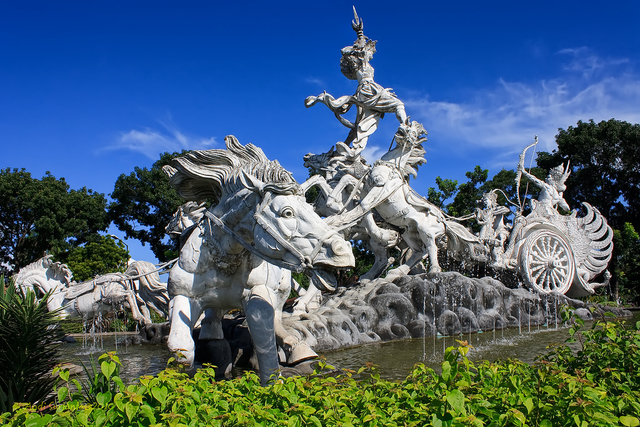This bright monument welcomes tourists arriving in Kuta at the intersection of Airport Street and Tuban Street.

The statue was erected in 1993 in honor of the legendary warrior Gatot Kaca, the son of Bima, one of the brothers of the Pandavas in the Indian epic Mahabharata.
Even during the wanderings of the Pandavas in the forest, Gatotkacha appeared whenever they thought of him, and repeatedly helped the Pandavas: he protected them from dangers, and carried them on his shoulders.
On his mother's side, Gatotkacha was a rakshasa, a giant, and possessed many mystical powers, which made him an important warrior in the key battle between the Pandavas and the Kauravas at Kurukshetra.
The sculpture depicts a scene from the Mahabharata, namely the moment of the battle between the Pandava brothers and their relatives, the Kaurava brothers. Gatot Kaca fights with Karna, a Kuru prince.
Gatotkacha, unknowingly, became part of Krishna's cunning intrigue. In the battle of Kurukshetra, Krishna (being Arjuna's charioteer), constantly tried to avoid a clash between Arjuna and Karna, while Karna had a magical dart given to him by the god Indra, called Amogha ("unavoidable").
Krishna ordered Gatotkacha to fight Karna. Unable to defeat the mighty rakshasa, Karna, as Krishna had hoped, was forced to resort to the help of the magic dart. Gatotkacha was killed, but Krishna's plan was carried out, and he saved the main warrior of the Pandavas, Arjuna, from death.
Out of joy at the death of Gatotkacha, Krishna began to dance, which was considered by the grieving Pandavas to be inappropriate behavior. Gatotkacha got his name because of his head, which was completely bald and had the shape of a pot (in Sanskrit, "ghata" means "pot," and "utkacha" is translated as "bald").
It is believed that in addition to its architectural value, the monument has spiritual power and serves as protection for flights at Ngurah Rai Airport.
You can add one right now!